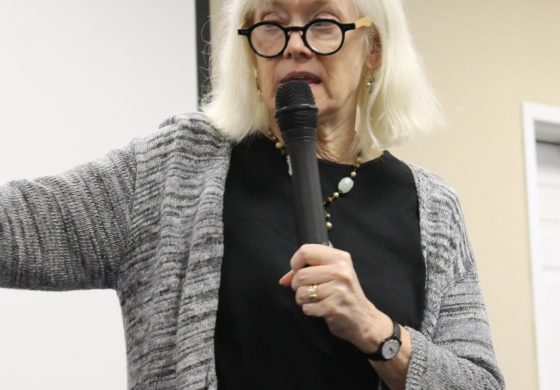By Page H. Gifford
Correspondent
Caroline Preston has loved scrapbooks and scrapbooking since she was a teen. Growing up in the 1950s and early ’60s, she was part of the post-war Baby Boomer generation. The World War II era that fascinated her became the subject of her current novel, The War Bride’s Scrapbook, which follows a young couple with the war as the backdrop affecting their lives.
Preston has a unique approach to her novel ideas, using scrapbooks as a jumping off point to create her stories.
“I was always fascinated by scrapbooks and collected antique ones when I was young,” she said. “They tell good stories but the frustration is that they end before we know what the ending is.”
Friends of the Library members gathered to listen to her explain how she uses her scrapbooking skills to tell a story. She encouraged others to preserve their memorabilia and tell their stories for future generations.
Many of those in attendance were fascinated by how their parents and grandparents lived and wanted to learn more, solve family mysteries or fill in the gaps. Genealogy is trendy among older Baby Boomers. But those in attendance – including Preston herself – admitted their children were not likely to search through old scrapbooks and boxes full of postcards and other souvenirs, and may not share the sentimental attachment to those items. Preston gave them an opportunity to think of ways to present their collection of photos and memories in a way that their children and grandchildren might appreciate.
Preston majored in American studies at Dartmouth College and earned a master’s in American civilization from Brown University. It was clear that the past is important to her. Inspired by her interest in manuscripts and ephemera, she worked as an archivist at the Rhode Island Historical Society, the Peabody-Essex Museum and Harvard’s Houghton Library. Nowadays, she spends her time writing novels based on visual stories told in scrapbooks.
She has published a similar novel, The Scrapbook of Frankie Pratt. It is a coming-of-age novel in the form of a colorful scrapbook, a visual journey set in the wild and often forbidden bohemian culture of the 1920s. It features an endearing, unforgettable heroine. Preston uses an array of vintage memorabilia – postcards, letters, magazine ads, catalog pages, fashion layouts and menus – to tell the story of Frankie Pratt.
“She is a spirited and ambitious young woman who grows up in New Hampshire, attends Vassar, then goes to Greenwich Village and to Paris,” said Preston, describing her freewheeling heroine.
One offbeat thing that inspired Preston to write The War Bride’s Scrapbookwas her mother papering a bathroom in their house with covers from magazines like The New Yorkerduring World War II.
“The bathroom remained that way for many years until recently when it was sold and the new owner replaced all of the magazine covers with leopard wallpaper,” Preston said. Seeing photos of the bathroom was like walking into the past.
She then discussed the details of the book and the research she did on the era. Historical fiction novels have become a genre unto themselves. Preston’s previous books focus on real life characters, including F. Scott Fitzgerald and Jackie Onassis, and fictional main characters who have interactions or other connections with the historical figure.
Her World War II scrapbook-novel “tells stories from the home front through a variety of examples, such as magazine articles that dealt with living without a mate, it was all right to date, and if you cannot cope with your 6-year-old child send him to boarding school,” she said. “There were also maps for tracking soldiers… I based the story on a woman named Lila Gerome, who died at 92 but had among her things a scrapbook she kept from 1943-1945. The story parallels her life on the home front and his life overseas.”
Preston’s story follows a young woman who rents a room to an architect and artist who is a combat engineer in the army. Eventually they impulsively elope before he goes off to war. They know very little about each other prior to marrying but learn more during his time away from home through correspondence and his drawings of places he had been.
“Many of the soldiers would record their last message before leaving and send it to their loved ones,” she said. ”The list of war dead that were posted in papers and photos of dead soldiers brought the reality of war home.” Like many women of her day, the heroine had ambitions and wanted to be an architect.
Eventually, he returns after being wounded and has been transformed by the war.
“Everyone returned to their lives in the post-war boom, women returned to the home, men to their jobs, but the men had been transformed by their experiences and in this ideal post-war culture no one was dealing with PTSD and alcoholism,” she said.
Society had put behind them many horrific years of war and, while not as devastating as what Europe endured, families and relationships were affected and many were never the same. The soldiers who returned kept their pain and suffering hidden behind closed doors.
Looking at the ads for that era spoke volumes of who Americans were at a time of idealized cultural perfection, ignoring what would take several decades to acknowledge.
For more information about Preston or her books, visit https://carolinepreston.com/.





